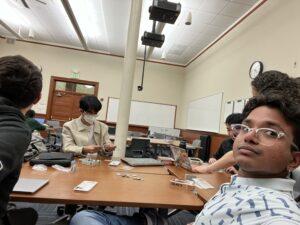Target Audience: 5-10 community members for ages 13+
Name of the game: The Resistance
Creator of the Game: Don Eskridge (Designer), Published by Indie Boards and Cards
Platform of the Game: Analog (board game)
The game fosters constant discussion amongst the players and every move leads to interesting insights which can be used to deduce the player’s identity. The primary kinds of fun experienced are fellowship and narrative.
The narrative of a group of soldiers with some spies in it with the objectives of carrying out missions makes the game adventurous and the players are transferred to a new world different from their everyday lives, which also adds to the tension in the game.
The game is asymmetric with two teams – one of the teams (team spy) has full knowledge of the players’ identities making the game even more challenging for the other team (team non-spy). Since the game requires voting for each round, the votes themselves leak information about a player’s incentives. These actions are often used to make accusations against players to encourage them to speak up. Unlike Mafia, where players can stay quiet and not attract any attention, here the players are making some moves which can always attract attention. So this leads to a more equitable discussion with well-distributed talk times.
Since the players are not eliminated unlike Mafia, the players can continue to have fun throughout the game. The “circle of magic” is active throughout the game.
The roles of the players are interesting – the identity associated leads to a sense of fellowship with the other players in the game. The fellowship could either be feeling that the two are in opposing teams or in the same team if you are on the non-spy team (which has incomplete knowledge). Players on the spy team need to be good at feeling camaraderie with the opposing team to blend well.
The non-spy team members tend to speak more and sometimes make claims against people which are incorrect due to which they tend to fall in a weaker spot especially when this game is played for the first time by the people. With multiple iterations of playing, the behavior would change, however, this is my analysis based on the first round of playing.
When there are subsets of players who know each other they tend to make the game dynamics more interesting because they tend to accuse each other more often and lead to more confusion.
Another interesting dynamic is that a non-spy once suspected as a spy tends to start behaving more suspiciously and is unable to recover sometimes. For example, a player kept saying that they are non-spy and should be recruited for the mission. But, the player was unable to make a convincing case every time they were questioned. This leads to frustration as effectively a player is unable to prove his identity. However, if played with low stakes and only for fun, then this can also lead to fun.

Fig: A picture of our group at the end of the game night when we are wrapping up. We ended up playing The Resistance and Coup.



